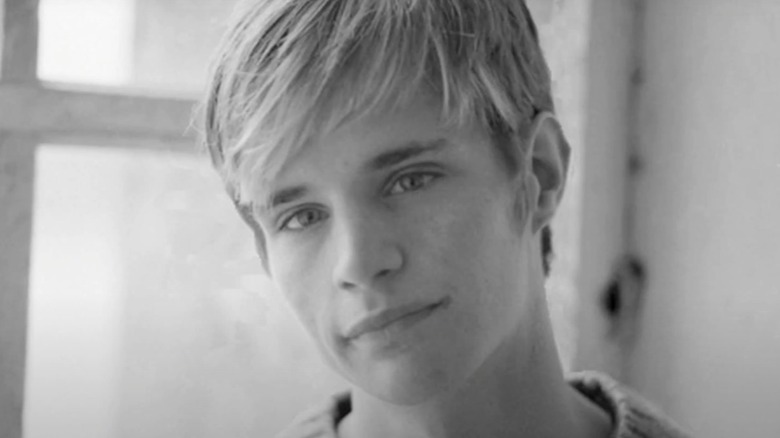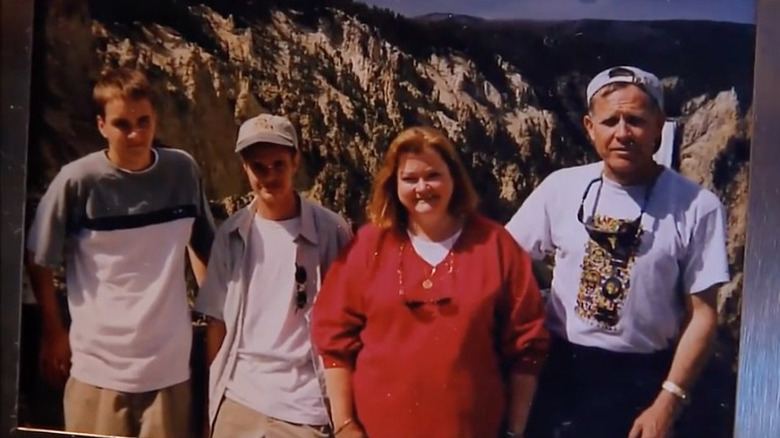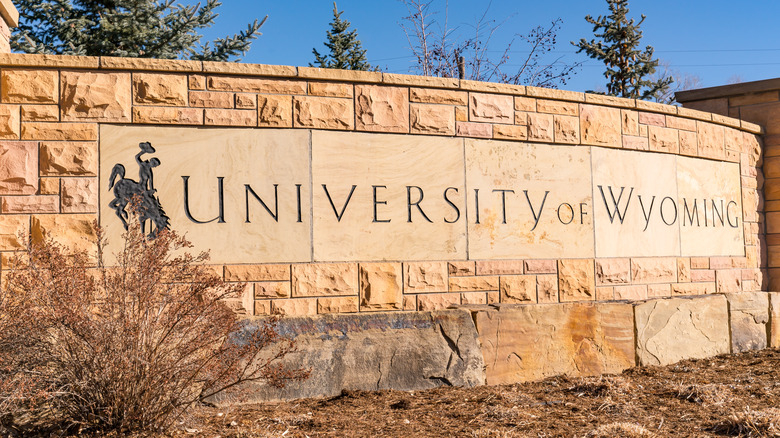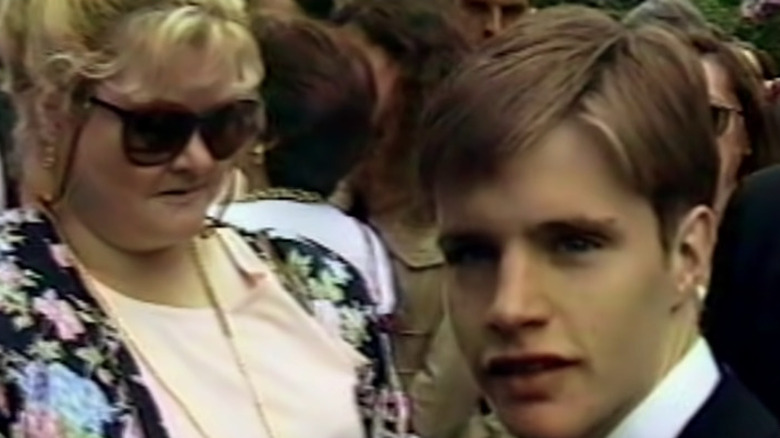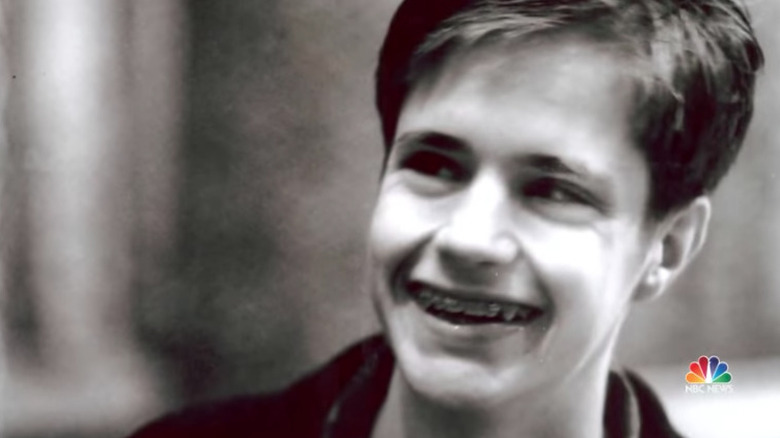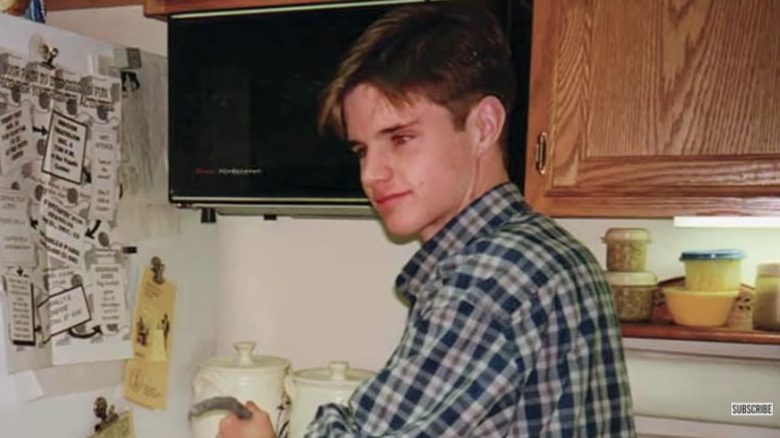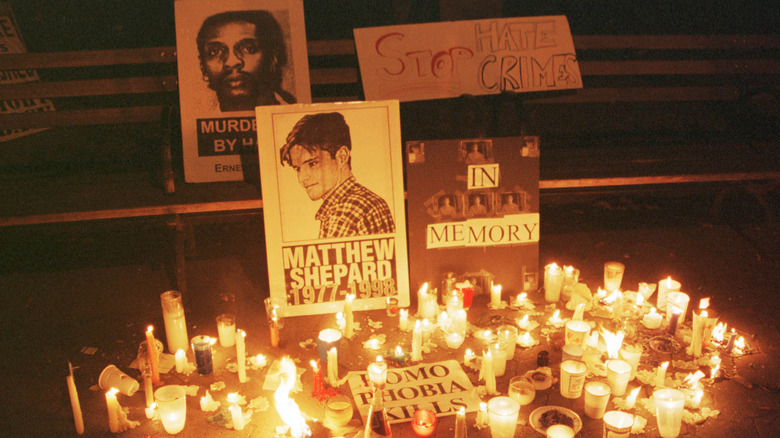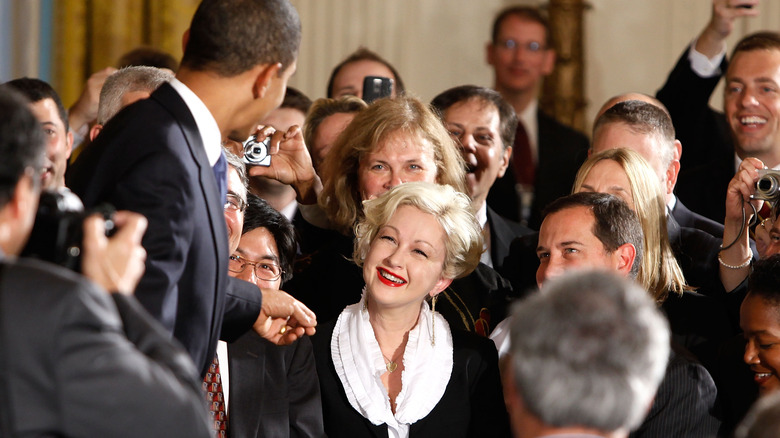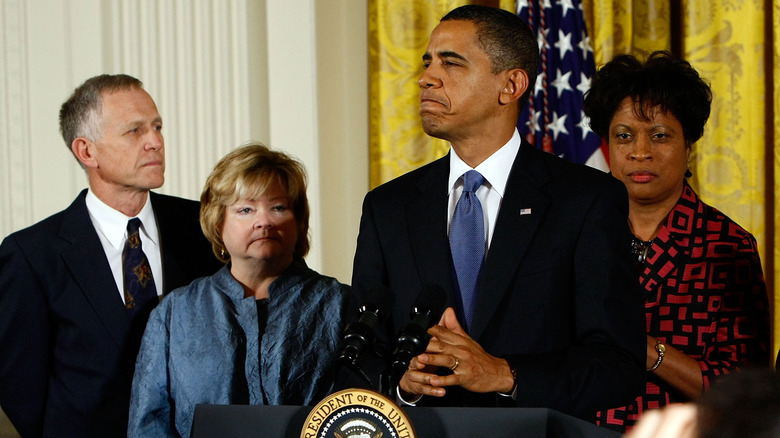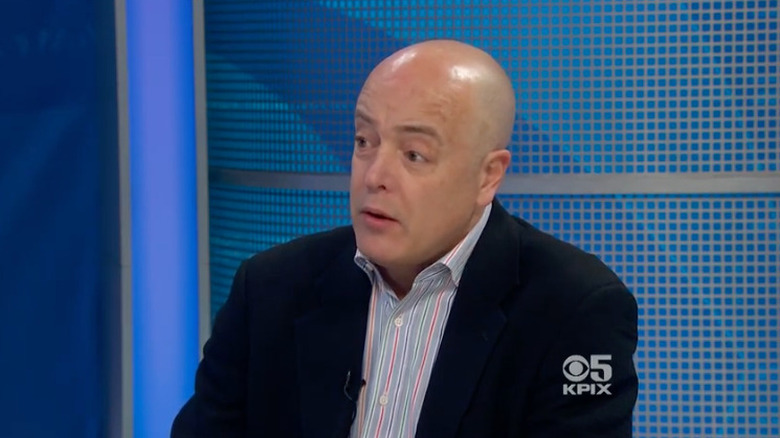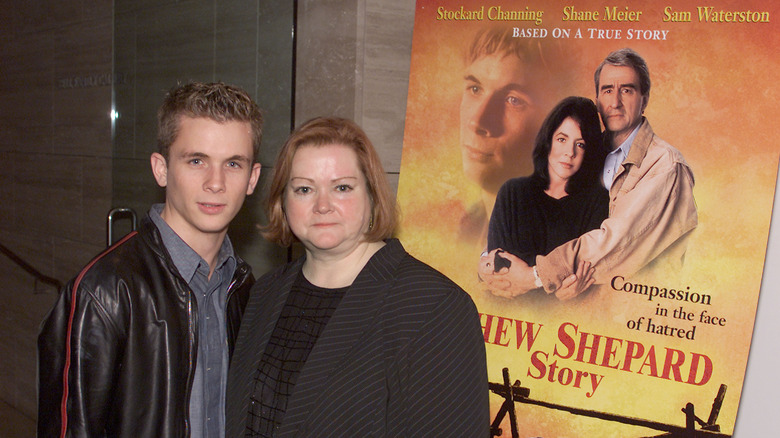The Untold Truth Of Matthew Shepard
Matthew Shepard was a friendly 21-year-old resident of Laramie, Wyoming who dreamt of changing the world. He was openly gay and devoted his time to LGBT+ causes. He felt guilty about his well-to-do upbringing and wanted to give back by helping others, but he was also an average college kid who drank too much and struggled to attend classes. He had several friends and easily built a rapport with strangers. Someone like Shepard, blessed with charisma and a sense of purpose, seemed destined to make a name for himself. But before his first semester at his new college was over, he became the victim of one of the most brutal anti-gay hate crimes in American history.
On October 6, 1998, Shepard attended the Fireside bar, a gay-friendly locale. He met two men his age, Russell Henderson and Aaron McKinney, who pretended to be gay and convinced Shepard to leave with them. In the next several hours, Shepard was robbed, severely beaten, and left to die on an open field. He succumbed to his injuries days later on October 12, per Vanity Fair. Shepard's murder quickly made headlines and forced Americans to confront the intolerance and ingrained hatred targeted at LGBT+ people. His death led to the first federal legislation to specifically protect members of the LGBT+ community, (per the GLBT Archive), and his legacy is defined by a matter once important to him: human rights. Read on for more untold truths about gay rights icon Matthew Shepard.
He knew he was gay from an early age
Matthew Shepard knew he was gay from the moment he saw photos of women's bodies and realized he didn't react the same way as his heterosexual friends. He was in his adolescent years when he and his friends peered into magazines, but the experience wasn't exciting for him. It was when he saw photos of men that he could relate to their feelings. Shepard didn't tell his family and friends he was gay until after he graduated high school, and he struggled to tell his parents.
According to Shepard's friend Brian Gooden, his parents took more time to accept his sexuality than he would've liked. Shepard spent a long time trying to ease his parents to the news by dropping hints, and on one occasion, left a gay magazine out in the open so they can spot it. They merely returned it to his bedroom without a word. Gooden said that Shepard's mom held onto hope that Shepard was only going through a phase, but she says she knew about his sexuality for a while. She sensed it from the times he interacted with girls who liked him. She knew his being gay wasn't a choice. The hardest struggle for Shepard lay in telling his father. In fact, Dennis Shepard wondered why his son was so hesitant to inform him. Matthew would make himself uneasy by imagining the worst case scenario from his dad's response, according to Vanity Fair.
His family moved to Saudi Arabia
In the middle of Matthew Shepard's high school years, his family moved to Dhahran, Saudi Arabia, where his father worked as an oil safety engineer. But Shepard attended school elsewhere; since there was no American school in Dhahran, he attended a school in Switzerland. There, he learned German and Italian and was involved in the theater program, per Vanity Fair.
It was also there that he met Michele Josue, a classmate who later made a documentary about his life titled "Matt Shepard Is a Friend of Mine." She described Shepard as a people-person who treated everyone well. Their friendship made an impact on her and drove her to unmask who he was as a person. So much media coverage focused on the circumstances of his death, and she wanted to shed light on Shepard's life. Her documentary was made for educational purposes so that students can watch it in schools and learn Shepard's story, according to The Advocate. Shepard's school T-shirt from his time in Switzerland was donated to the Smithsonian's National Museum of American History, given by his parents, per the Behring Center.
He was assaulted during high school
While attending The American School in Switzerland, he took trips with friends in Europe, Asia, and the Middle East, per "Matt Shepard Is a Friend of Mine" (via Cinema Girl). One trip to Morocco left Shepard scarred. He had gone out at night alone to a coffee shop, where he socialized with some German exchange students. While returning home, he was ambushed and gang raped. The perpetrators took his shoes. He sought help from Moroccan authorities, but his abusers were never caught. He then lived with his parents in Saudi Arabia and attended therapy, but the incident traumatized him. His mother said he was never the same after the trip.
He began to feel paranoid about his safety and was distrustful of people. He suffered from nightmares and flashbacks and developed anxiety and depression. Shepard was preoccupied by thoughts of his perpetrators and wondered what came of them. He was motivated to counterbalance his fear of people by over-trusting them. This led him to put himself in danger, like walking alone at night while living in Denver, according to Vanity Fair.
He was part of his college's LGBT+ group
The day he was murdered, Matthew Shepard attended his college's L.G.B.T.A. meeting, which he did regularly. They were planning for their school's Gay Awareness Week, which would've taken place the following Monday. When deciding which college and town to settle in, he prioritized finding a community and more specifically, a gay community. He was friends with other members of the group, and one member confided to the group a homophobic incident he was subjected to before the meeting. After the last meeting Shepard would ever attend, they hung out together at a restaurant called the Village Inn.
The L.G.B.T.A. held a march at the school's homecoming parade the Saturday after Shepard's death. They wore yellow armbands and carried signs reading "No Hate In Our State." Kim Nash, a member of the L.G.B.T.A., believed Shepard's death made hatred against their community more taboo. On the other hand, Shepard's death caused one of his friends to reconsider being openly gay, per Vanity Fair.
He wanted to be a human rights advocate
From an early age, Matthew Shepard was drawn to politics. He would talk politics with adults at his town's hairdresser shop and dreamed of becoming president. At the University of Wyoming, he studied political science with a minor in languages, per Vanity Fair. Perhaps inspired by his trips abroad during high school, Shepard developed an interest in international human rights, and specifically, women's rights in the Middle East and Asia. He saw himself working in the State Department in order to advance human rights abroad, per ABC News.
Shepard was hard on himself as a student. His fear of failing in college had an impact on his mental health. He also struggled with an attention deficit disorder, which impacted his grades. He suffered from panic attacks that caused him to get behind in classes. Before attending U.W., Shepard took classes at Catawba College in Salisbury, North Carolina and then Casper College in his hometown of Casper, Wyoming, per Vanity Fair.
He suffered from depression
Matthew Shepard suffered from periodic clinical depression and anxiety, which was perhaps contributed by his traumatizing assault in Morocco. His mother said the trip had changed him, and after the assault, he sought out therapy while staying with his parents in Saudi Arabia. While living in Denver after high school, Shepard considered joining an assisted-living home called Karis Community, which was run by mental-health professionals. Instead, he enrolled at the University of Wyoming in Laramie, believing he would flourish in the town's small community. He also believed it would provide a sense of safety that he longed for ever since his assault. He grew sensitive to stories and depictions of violence and carnage and once struggled to recuperate emotionally after a screening of "Saving Private Ryan."
Shepard engaged in reckless behavior in order to counter his paranoia and fear. He considered enrolling in an intensive therapy program if his time at the University of Wyoming didn't work out. He was hospitalized on multiple occasions for depression and suicide ideation and took antidepressants and anti-anxiety pills. Shepard was also unsatisfied with his therapy treatment and was on the lookout for someone he could confide in, per Vanity Fair.
He was HIV positive
Matthew Shepard was aware of the risks of an HIV infection and told a close friend that he always used protection. However, after Shepard was admitted into the hospital following his attack by Aaron McKinney and Russell Henderson, doctors diagnosed him as HIV-positive. Additionally, Shepard's attackers had used the bloodied gun they beat Shepard with on two other victims, Emiliano Morales and Jeremy Herrara. They had to undergo treatment in case they were infected with Shepard's blood. His attackers were also considered at risk of infection. A Laramie journalist covering Shepherd's death told Vanity Fair that this would've been cosmic justice.
Shepard's friends were afraid that news of his HIV status would make strangers feel less outraged about his murder since HIV was deadly, anyway. Indeed, news of Shepard's HIV infection was used against him. Those sympathetic to his attackers painted a picture of a seductive Shepard who deliberately tried to infect McKinney and Henderson, but people close to Shepard believed he was unaware of his infection, especially since he hadn't told anyone of it. His mother knew that Shepard had routinely gotten tested after he was sexually assaulted in Morocco, and these tests always came back negative. His friends and family didn't believe he would've kept such information secret because of his open manner. They also believe that Shepard wouldn't have wanted to contribute to the stigma surrounding HIV by keeping it secret, according to Vanity Fair.
His murder made national news
Matthew Shepard's brutal death caused outrage and sympathy all over the world. His image graced the cover of Time magazine and news of his murder made the front page of The New York Times. There were thousands of candlelight vigils held all around America, and Shepard's parents received 10,000 letters and 70,000 emails, according to the LGBT Archive. They received gifts, as well, including a quilt from a Pittsburgh college, items from vigils held, CDs, poems, stuffed animals, books about grief, and money, among other things (via Vanity Fair). Members of the L.G.B.T.A. college group Shepard was part of made television appearances, and five days after his murder, people gathered outside the US Capitol for a vigil. A few celebrities made appearances, per The Guardian.
Unfortunately, the attention resulted in a homophobic backlash. Anti-gay protesters, often religiously-motivated and members of extreme Christian sects, swarmed Shepard's funeral and shouted hate-filled chants. Funeral attendants did their best to shield Shepard's family from their harassment. One thousand people attended his funeral, according to The Guardian. Anti-protesters arrived at the murder trial, too, but counter-protesters who dressed up as white angels drowned out their voices, per the LGBT Archive.
Celebrities organized after his death
The hate-motivated murder of Matthew Shepard motivated several celebrities to take action. Ellen DeGeneres and Ted Kennedy spoke at a vigil held in his honor on the steps of the US Capitol. DeGeneres made a personal connection to Shepard's murder, saying his murder was the reason why she came out as a lesbian on her talk show. Kennedy, along with the other celebrities in attendance, advocated for the passage of a hate-crimes bill, per The Washington Post. Elton John sent flowers to his funeral and held a benefit concert at the University of Wyoming, per UC Davis.
Additionally, Madonna called the office of University of Wyoming president Philip Dubois to make a heated complaint. According to Dubois, Madonna talked to his secretary for 40 minutes only to criticize Wyoming, the university, and Dubois' leadership. He believed that she, along with the national media, made unfair judgments about Wyoming in order to form a convenient narrative about Shepard's murder. He concedes, however, that residents were too defensive and ignorant of the hate their community was capable of, according to UC Davis. Barbra Streisand also took action by calling the Albany County sheriff's office and urged for an expedited response on the case, per The Guardian. In 2009, Cyndi Lauper was in attendance for the signing of the Matthew Shepard and James Byrd, Jr. Hate Crimes Prevention Act, per Getty Images.
His parents became activists
When news of Matthew Shepard's death spread across the country, Judy and Dennis Shepard received thousands of dollars in donations. With the money, they formed the Matthew Shepard Foundation in order to donate to causes their son believed in—mental health, the LGBT+ community, AIDS awareness, and help for homeless teenagers. It was one of their first forays into helping the LGBT+ community and bringing awareness to issues concerning them. They have also created Matthew's Place, an online resource for family and friends of LGBT+ members that provides various links to similar organizations. For eight years, the Shepards have stood by the passage of a hate-crimes bill that would've been the first federal legislation to recognize the specific rights of LGBT+ people. It was finally passed in 2009 by President Barack Obama with the Shepards in attendance, per the GLBT Archive.
The Shepards have been conscientious about the work they do, making sure to research issues before throwing political support behind them. Despite the fact that Judy initially felt discomfort in becoming a public figure, she has made a career in public speaking for issues important to the Foundation. In 2009, Judy published "The Meaning of Matthew," which detailed their experiences in the aftermath of Matthew's death, from the murder trial to their subsequent activism, per the National Democratic Institute. In 2019, the couple was honored by the Human Rights Campaign Foundation for their advocacy, per HRC.
A journalist alleged he was a meth dealer
In 2013, journalist Stephen Jimenez published "The Book of Matt," which put forth a controversial theory that Matthew Shepard's murder was motivated by drugs and not homophobia. Jimenez, who initially believed in the prevailing narrative that Shepard's murder was a hate crime, traveled to Laramie, Wyoming to conduct research for a screenplay. He said it was there that he learned Shepard dealt crystal meth and heroin and that he previously had sexual relations with one of his murderers, Aaron McKinney. Shepard was purportedly in possession of $10,000 worth of crystal meth, and McKinney and Russell Henderson wanted to steal it. Police officer Flint Waters, who was at the crime scene, believes that the two men were trying to find Shepard's home. He also said he once caught McKinney having sexual relations with another man, per The Guardian.
Jimenez, who is gay, was criticized and accused of revisionism. The Matt Shepard Foundation disavowed Jimenez's findings, and the Laramie police commander at the time repudiated the idea. The lead sheriff's investigator said the idea of Shepard being a drug dealer was "truly laughable," per The Bay Area Reporter. Additionally, the coroner who conducted Shepard's autopsy verified that there were no traces of meth in his system, per the Casper Star Tribune. Journalist JoAnn Wypijewski subscribes to a more nuanced theory in which Shepard's death was motivated by homophobia but aided by an environment rampant with drug abuse, per NPR.
He became a LGBT+ rights icon
Matthew Shepard's death became a catalyst for changes in federal law on hate crimes and spurred progress in the national conversation about LGBT+ rights. Naturally, he became a LGBT+ icon and a symbol for tolerance. Most famously, his story was the center of the play "The Laramie Project." Members of the Tectonic Theater Project in New York City traveled to Laramie, Wyoming and interviewed residents and documented their reactions and emotions to Shepard's murder, per the Matthew Shepard Foundation. It debuted in 2000 and is frequently played in college and community theaters across the country. It received a screen adaptation on HBO in 2002, according to the GLBT Archive.
Several years later, the play received an epilogue called, "The Laramie Project: Ten Years Later." Members of the Tectonic returned to Laramie in order to examine the murder's legacy. Playwright Moises Kaufman said he made the follow-up play in order to counter the theory that Shepard's death was a result of drugs instead of homophobia, per NPR. There have been numerous documentaries, songs, and movies dedicated to Shepard. In 2002, a made-for-TV movie depicted Shepard's story. Stockard Channing, who portrayed Judy Shepard, won an Emmy for her role, per IMDb. The documentary "Matt Shepard Is a Friend of Mine" also won an Emmy, per IMDb.
